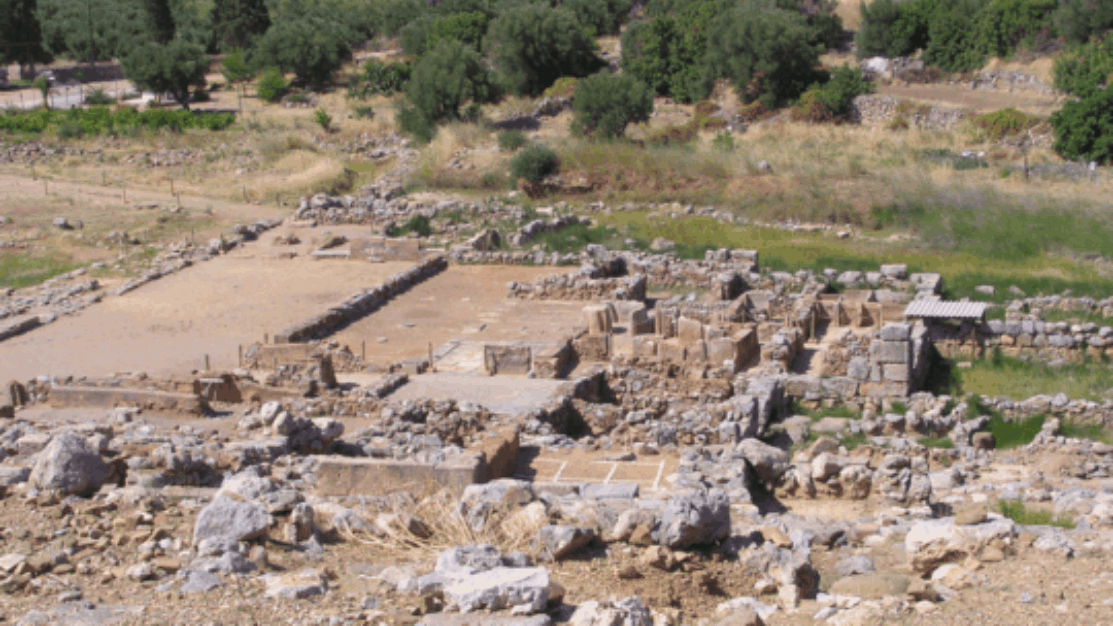The fourth largest palace of Minoan Crete, base of the Fleet, trade center and secret keeper!
A few meters from the seaside of the small coastal settlement of Kato Zakros, there is a palace. A majestic paved road starts from the port to end at its main gate. From there, a corridor leads to the courtyard, the heart of the palace, which is surrounded by four wings of 300 apartments, all floors included. It is all built so intricately, justifying the myth of the Labyrinth.
The palace is over 8.000 sq.m. in size, along with the surrounding supporting buildings. It may be 5 times smaller than Knossos, but follows the general architectural design of the other palaces.
Fun fact: Archaeologists have brought to light an entire Minoan city surrounding the palace, with paved streets and building blocks of 2-4 houses of two or three storeys, with various rooms.
The Palace of Zakros was first built in 1.900 BC, and reconstructed in 1600 BC. (Neopalatial period). The ruins of today come from this second building. Like the other Minoan palaces, it was completely destroyed by fire around 1.450 BC and not rebuilt. It is the fourth largest among the administrative centers of the Ancient Cretans, after Knossos, Phaistos and Malia.
Its location, Kato Zakros, forms a natural cove, which is connected to the nearby Ano Zakros, the village of springs and olive groves. The location of the settlement is strategic, naturally protected. It is for this reason that the palace built there was a trade and administration center and an important base of the Minoan Fleet in Eastern Crete.
The first reference to Zakros as an archaeological site is made in the book “Travels in Crete” by the English admiral and traveler Th. Spratt. However, the real significance of the site was first realized by the archaeologist who excavated Knossos, Sir Arthur Evans, when he visited Zakros during his travels to the island in 1984. Evans encouraged archaeologist David Hogarth, director of the British School in Athens, to excavate the site. Indeed, Hogarth discovered Minoan buildings, tools and clay seals, indicating extensive activity in the area; but, due to the fact that he almost drowned in a strong hurricane in 1.901, he left, abandoning the project.
The palace, along with the surrounding Minoan city, was to be discovered 60 years later, in 1961, by Professor Nikolaos Platonas. His son, Lefteris Platonas, Dr. of Prehistoric Archaeology at the University of Bristol, continues the work of his systematic excavations, which lasted 30 years, by recording and evaluating the findings.
The palace was found intact, with findings of great value in terms of deciphering the secrets, culture, art and lifestyle of the Minoans. In the west wing, a place of worship, there were rooms for rituals and banquets, the main sanctuary with the purification tank and the treasury full of ritual utensils. Offering vessels, cups, goblets and amphorae made of rare materials, such as faience, ivory, obsidian, alabaster and veined marble, were found. Indicatively, the bull head - shaped rhyton, the peak sanctuary rhyton, the rock crystal rhyton, an exquisite work of art, were found there. Gold leaves, jewelry, and huge two-handed copper saws, up to 1,70 m long, were also among the findings.
Fun Fact: 13 Linear A’ tablets were found in the Archives Room, shelved in clay boxes, baked and preserved by fire
The King and Queen's apartments were on the east wing, along with a large space that had a 7 m in diameter, round outdoor tank in its center, where spring water was collected. It was supported by at least five columns and there were eight steps to climb it. To its south, there was an underground fountain and, to its west, a built well.
Fun Fact: In the built well of the palace, water has preserved the wood of its mechanism; and at its wall, a cup full of olives preserved for 3.500 years, still bearing their flesh, was found.
To the north, there were storage, bath and kitchen facilities, serving the needs of the royal apartments, a paved gallery with two wooden columns leading to the courtyard and the large staircase leading to the upper floor. In the southern part, there were workshops where perfumes from local aromatic herbs were prepared, as well as a garden.
Fun Fact: Nowadays, the Queen's bath is used by the turtles of Zakros! They only live inside the palace cisterns and scientists believe that the palace turtles belong to a rare sea turtle species that has probably survived from the Minoan era.
Abrupt mass exodus: When the palace was discovered, it seemed as if its occupants had abruptly abandoned it, all at the same time. Abandoned tools in the workshops, cooking utensils in the stoves, walls razed to the ground, as if they had been pushed from the east to the west, and jars pressed against the walls of the warehouses. The eruption of the Volcano of Santorini was most probably the reason.
The dead have secrets.
Away from the Minoan city, another world emerges. A gorge of eerie beauty, leading from Ano to Kato Zakros, specifically the caves located on its slopes, the burial place of the time. Hikers cross it today, to sense the energy stemming from its wild and imposing interior. Archaeologists uncover secrets in the Gorge of the Dead.








